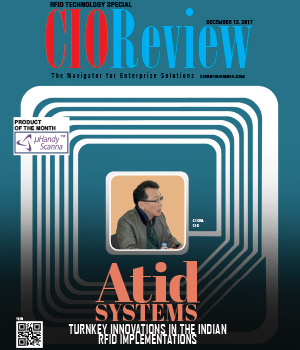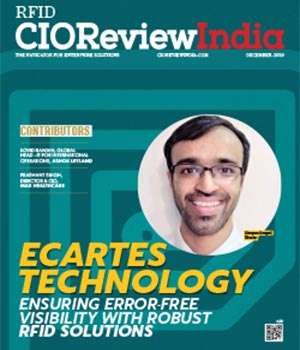
RFID- Trends To Watch Out For In 2020
Prashant Singh, Director & CIO, Max Healthcare | Monday, 09 December 2019, 08:42 IST
 Healthcare industry is going through interesting times. It is moving from products and services to solutions. There is much research to make huge strides in newer medicines and treatment approaches. On the other hand, the way the providers and patients are interacting is changing at a never before seen pace. However, the thing that remains constant in these unpredictable and disruptive times is the patient who has become more demanding.
Healthcare industry is going through interesting times. It is moving from products and services to solutions. There is much research to make huge strides in newer medicines and treatment approaches. On the other hand, the way the providers and patients are interacting is changing at a never before seen pace. However, the thing that remains constant in these unpredictable and disruptive times is the patient who has become more demanding.
With the advent of innovative technology in all facets of life of a patient, the need is to make use of the available technologies in healthcare too. With focus on the patient safety and quality of care, technology has helped in improving efficiencies, leading to potential savings according to various available studies.
Though real time locating systems have been in use in other industries for quite some time, its use in healthcare is still in initial stages. It has started making inroads in supply chain, asset management areas in a hospital; however, it is still far away from adoption to its full potential for reaping in huge benefits in terms of cost savings, bringing in efficiencies and improved customer experience.
Radio frequency identification (RFID) refers to a wireless technology that uses radio-frequency waves, electromagnetic fields to identify and track tags attached to the objects. RFID system comprises two components including tags and readers. Each RFID tag has a processor and an antenna. Tags can be active, use a battery or passive, and use power from the reader. Readers can be handheld or stationary. They vary in size and strength based on their purpose.
”While there are challenges to this technology, the benefits are far more as has been evident and tested in other sectors. It is time that the healthcare starts adopting this measure”
The global RFID in healthcare market size is expected to reach USD 10.65 Billion by 2025, according to a new report by Grand View Research, Inc. It is projected to expand at a CAGR of 22.4% during the forecast period. Some of the key contributors to the growth include rising focus on reducing operational costs and streamline the workflow, demand for efficient supply chain management, and need to improve the quality and efficiency of care.
Industries like pharmaceutical companies, medical device manufacturers etc., are integrating this technology with other systems to control inventory costs. It is useful in laboratories, blood banks, and pathology labs for efficient product tracking and better workflow management. This can be used for patient tracking across different hospital sections like ER, OPD etc., to reduce waiting times and is thus gaining significance in hospitals. Growing requirement for reduction in operating costs is further expected to drive the increase in adoption of RFID.
Trends to watch out for:
Some upcoming trends where RFID and related technologies can be used in big way in healthcare are as below:
1. Inventory tracking and Authentication - Typical inventory tracking solutions (as with many industries) involve manual counts and barcodes, which take time for staff members to complete. Using RFID can reduce the amount of time spent counting, ensuring accurate data and ready information on types and amounts of drugs at hand. This, integrated with Hospital information systems with defined reorder entry levels, can be used for auto orders and alerts as defined.
It can also be used for authentication to prevent counterfeiting of life saving and high cost items at store level. The specific information is encrypted on RFID tags which can then be decrypted by authorized personnel before issuing for use, thereby helping in maintaining quality.
2. Patient and Staff tracking – Patients are given RFID enabled wristbands used for identifying (passive RFID) and tracking (active RFID). Information encoded on the wristband’s tag is an optimal way of identifying patients in emergencies, ensuring patients are not given the wrong medication or sent to the wrong area in the hospital. Important information encoded on the wristband such as allergies etc could play a critical role in the patient’s outcome. It has much use in tracking movement of new born babies as a measure of patient safety. Recently, Hospitals have used active RFID in Real-Time Location Systems (RTLS) to track porter movement in order to find workflow bottlenecks by identifying how long they have been in certain areas and how long it took to complete a defined task. The data is reported to the management team for enabling them to take decisions for smart deployments and improving process efficiencies. A real-time tracking system offers a great way to streamline human resource allocation, lower costs and respond quickly to changing demands, thereby improving the workflow efficiency.
3. Surgical tool tracking with sterilization - Each year, studies show that surgical instruments in hospitals are found to carry bacteria from previous use because either they were not sterilized at all or were not sterilized properly. Not only could tracking these items with RFID tags ensure that each tool was sterilized prior to use as per the defined process, but also preventing loss or misplacing. As not all tags can survive the sterilization conditions, selection of proper tag is necessary.
4. Asset tracking – High value portable machines, ECG machines and other equipments shared between wards in a hospital can be effectively located with real time RFID solutions. This not only helps in preventing loss, but also ensures availability, preventing unnecessary delays due to time taken in locating. It helps to ensure preventative maintenance and inventory control, triggering alerts for purchase orders that would lead to over or understocks. Historical analytics helps better plan purchasing decisions and leads to cost savings.
5. Enhance patient/visitor experience – In many cases, patients and visitors have to navigate through a maze of hallways to get to their desired destination. By implementing an RTLS in combination with a mobile app, the hospitals have a unique opportunity to provide indoor navigation for points of interest (e.g. sanitation, catering facilities, patient rooms, treatment rooms) and the most optimal route to their destination leading to a better visitor and patient experience. The experience can be improved for an inpatient journey from admission to discharge. The provided real-time data enables to identify, for example, how much time patients spend in waiting areas, how long they stay in examination/treatment rooms and where else they spend time during their hospital stay. This gives staff a better insight and allows taking measures to act on pain points that can be identified using the data.
6. Patient safety - In hospitals, it can be difficult to keep medicated or confused patients safe, preventing them from getting lost or entering restricted areas. Positioning technologies like beacons can be used to locate patients as necessary and can be configured to send alerts if a patient leaves pre-defined areas. Patient monitoring can also contribute to fall prevention. An out-of-bed system that registers when a patient leaves his bed and a fall detection system immediately inform nursing staff and ensure fast medical aid. Other use case is to use it for maintain hand hygiene, where an alert goes in case the solution is not used before touching the patient.
Challenges and Concerns:
Every technology comes with some challenges. One of the biggest challenges reported regarding RFID technology is the cost of the system and the system’s return on investment (ROI). According to a recent study by Yazici (2014), the cost of an RFID tag can range from four cents per tag to upwards of $50.00 per tag, depending on the capabilities. Tags can be reusable or disposable and have associated costs. Reusable tags are higher in price and require a standardized cleaning technique before the tag can safely re-enter circulation. The size of most RFID tags are small and light in weight so as not to be cumbersome on equipment or a patient, however, it is easy for these tags to then be carried away from the hospital, causing a loss in tag inventory and therefore an unexpected cost for the organization. The RFID tag readers can range from $1,000.00 to $3,000.00 per reader. A fully functioning RFID system requires tags, readers, infrastructure, middleware, printers, and so on.
Technical limitations such as system errors, RFID tag readability, interference with medical equipment, and interoperability with other health information technology also impede adoption. Technical issues with the RFID technology include dependency on wireless network connectivity, and the inability of the radio frequency waves to reach some of the tags on the nurses and medication cart due to ceiling height. RFID hardware and software is yet to be standardized and therefore presents potential for interoperability concerns across providers (Coustasse et. al, 2015b).
Healthcare provider perceptions of the utility of a system can present barriers for implementation if there is no buy-in or acceptance.
In addition to organizational acceptance challenges and concerns, privacy and security concerns arise when considering RFID implementation. Yao, Chao-Hsien, and Li (2012) identified concerns for inappropriate collection, intentional misuse, or unauthorized disclosure of healthcare information due to inadvertent transmission or deliberate interception of the tag information.
In conclusion:
While there are challenges to this technology, the benefits are far more as has been evident and tested in other sectors. It is time that the healthcare starts adopting this measure. Taking care of some points might be helpful in deciding the approach:
• A thorough cost-benefit analysis of the business case.
• Testing of the technology prior to widespread implementation by doing a pilot study.
• Assess that the desired product is able to meet the anticipated goal of the implementation.
• Address limitations during the preparation stage. Acknowledgment of the limitations of the product will avoid over-expectations and define its capabilities to the users.
• Education on technology prior to implementation is recommended to ensure staff is aware of its value in practice and can utilize the technology as it is intended.
• Implementation of appropriate security measures to decrease the privacy and security concerns arising with availability of real time data in the system.
• Ongoing monitoring and assessment of the performance of RFID technology can help to confirm a wellfunctioning system.
CIO Viewpoint
Application Of RFID Is Expanding
By Kovid Ranjan, Global Head –IT for International Operations, Ashok Leyland
RFID- Trends To Watch Out For In 2020
By Prashant Singh, Director & CIO, Max Healthcare
Enterprise Security Management To Create And...
By Abhay Munje, Head IT, Safari Industries India Limited
CXO Insights
Open Standards as the Next Frontier in...
By Manjunath Bhat, Director R&D, AirWatch by VMware
Advent of Blockchain and Data Analytics in...
By Dr. MuditSaxena, Group CEO, CARE Hospitals
Energy Efficiency through Smart Solutions








